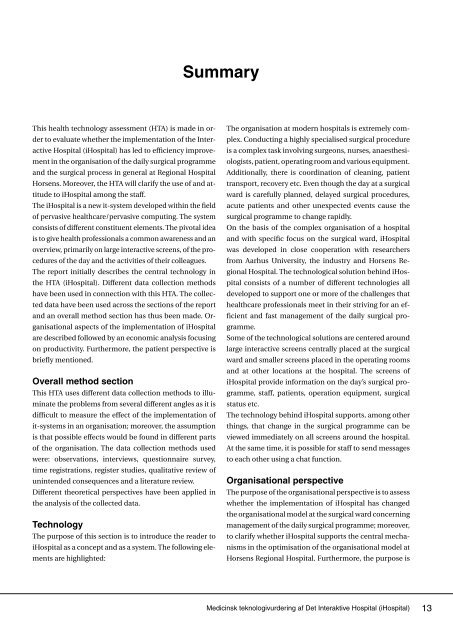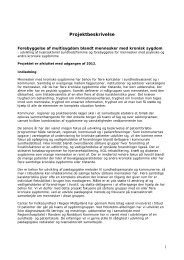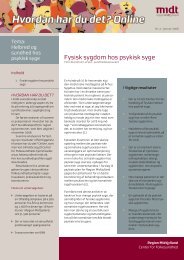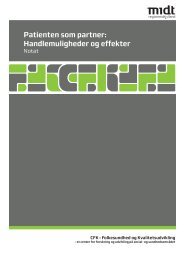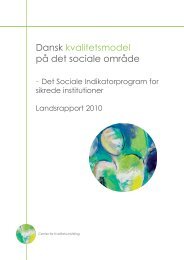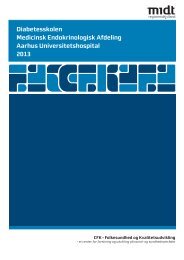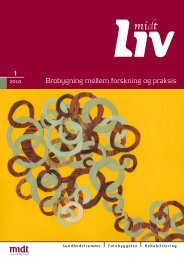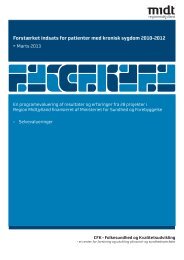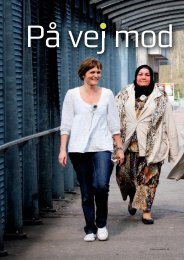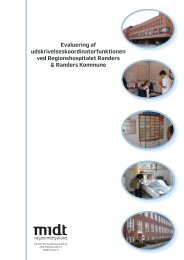Medicinsk teknologivurdering af Det Interaktive Hospital (iHospital ...
Medicinsk teknologivurdering af Det Interaktive Hospital (iHospital ...
Medicinsk teknologivurdering af Det Interaktive Hospital (iHospital ...
Create successful ePaper yourself
Turn your PDF publications into a flip-book with our unique Google optimized e-Paper software.
Summary<br />
This health technology assessment (HTA) is made in order<br />
to evaluate whether the implementation of the Interactive<br />
<strong>Hospital</strong> (i<strong>Hospital</strong>) has led to efficiency improvement<br />
in the organisation of the daily surgical programme<br />
and the surgical process in general at Regional <strong>Hospital</strong><br />
Horsens. Moreover, the HTA will clarify the use of and attitude<br />
to i<strong>Hospital</strong> among the st<strong>af</strong>f.<br />
The i<strong>Hospital</strong> is a new it-system developed within the field<br />
of pervasive healthcare/pervasive computing. The system<br />
consists of different constituent elements. The pivotal idea<br />
is to give health professionals a common awareness and an<br />
overview, primarily on large interactive screens, of the procedures<br />
of the day and the activities of their colleagues.<br />
The report initially describes the central technology in<br />
the HTA (i<strong>Hospital</strong>). Different data collection methods<br />
have been used in connection with this HTA. The collected<br />
data have been used across the sections of the report<br />
and an overall method section has thus been made. Organisational<br />
aspects of the implementation of i<strong>Hospital</strong><br />
are described followed by an economic analysis focusing<br />
on productivity. Furthermore, the patient perspective is<br />
briefly mentioned.<br />
Overall method section<br />
This HTA uses different data collection methods to illuminate<br />
the problems from several different angles as it is<br />
difficult to measure the effect of the implementation of<br />
it-systems in an organisation; moreover, the assumption<br />
is that possible effects would be found in different parts<br />
of the organisation. The data collection methods used<br />
were: observations, interviews, questionnaire survey,<br />
time registrations, register studies, qualitative review of<br />
unintended consequences and a literature review.<br />
Different theoretical perspectives have been applied in<br />
the analysis of the collected data.<br />
Technology<br />
The purpose of this section is to introduce the reader to<br />
i<strong>Hospital</strong> as a concept and as a system. The following elements<br />
are highlighted:<br />
The organisation at modern hospitals is extremely complex.<br />
Conducting a highly specialised surgical procedure<br />
is a complex task involving surgeons, nurses, anaesthesiologists,<br />
patient, operating room and various equipment.<br />
Additionally, there is coordination of cleaning, patient<br />
transport, recovery etc. Even though the day at a surgical<br />
ward is carefully planned, delayed surgical procedures,<br />
acute patients and other unexpected events cause the<br />
surgical programme to change rapidly.<br />
On the basis of the complex organisation of a hospital<br />
and with specific focus on the surgical ward, i<strong>Hospital</strong><br />
was developed in close cooperation with researchers<br />
from Aarhus University, the industry and Horsens Regional<br />
<strong>Hospital</strong>. The technological solution behind i<strong>Hospital</strong><br />
consists of a number of different technologies all<br />
developed to support one or more of the challenges that<br />
healthcare professionals meet in their striving for an efficient<br />
and fast management of the daily surgical programme.<br />
Some of the technological solutions are centered around<br />
large interactive screens centrally placed at the surgical<br />
ward and smaller screens placed in the operating rooms<br />
and at other locations at the hospital. The screens of<br />
i<strong>Hospital</strong> provide information on the day’s surgical programme,<br />
st<strong>af</strong>f, patients, operation equipment, surgical<br />
status etc.<br />
The technology behind i<strong>Hospital</strong> supports, among other<br />
things, that change in the surgical programme can be<br />
viewed immediately on all screens around the hospital.<br />
At the same time, it is possible for st<strong>af</strong>f to send messages<br />
to each other using a chat function.<br />
Organisational perspective<br />
The purpose of the organisational perspective is to assess<br />
whether the implementation of i<strong>Hospital</strong> has changed<br />
the organisational model at the surgical ward concerning<br />
management of the daily surgical programme; moreover,<br />
to clarify whether i<strong>Hospital</strong> supports the central mechanisms<br />
in the optimisation of the organisational model at<br />
Horsens Regional <strong>Hospital</strong>. Furthermore, the purpose is<br />
<strong>Medicinsk</strong> <strong>teknologivurdering</strong> <strong>af</strong> <strong>Det</strong> <strong>Interaktive</strong> <strong>Hospital</strong> (i<strong>Hospital</strong>)<br />
13


